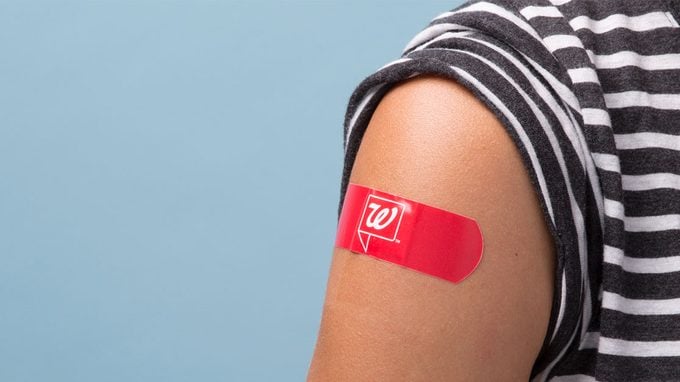How to Get a Flu Shot at Walgreens
Updated: Dec. 10, 2020
It's more important than ever to get your flu shot. Here's how to get yours at a local Walgreens, including how much it costs.
Getting the flu shot Walgreens
The Covid-19 vaccine isn’t quite ready for prime time in the U.S. But the annual flu shot is. That means you can protect yourself from at least one virus circulating this season. Getting a flu shot will not only help you, it will also help keep your loved ones safe. Every additional vaccination helps build “herd immunity,” making it less likely the virus will spread. (Also, avoid these flu myths.)
Today, getting vaccinated against the flu is easier than ever. According to the Centers for Disease Control and Prevention (CDC), almost one-third of all flu shots in the U.S. are given in a pharmacy or retail setting. That includes thousands of Walgreens locations across the nation.
Here’s what you need to know about the cost of Walgreens’ flu shot, its effectiveness, and risks. (And here’s what you need to know about the flu virus.)
How effective is the flu vaccine?
The influenza viruses change every year which means that the vaccines do, as well. Experts do their best to match the vaccine to the strains circulating each season. If the match is a good one, the vaccine is typically 40 to 60 percent effective. Even if the vaccine doesn’t protect you from getting sick, it will reduce your chances of becoming severely ill. (These are the flu vaccine “myths” that are actually true.)
Experts aren’t sure why this is, but it probably is linked with the body’s immune reaction to the vaccine, according to a study published in 2018 in Eurosurveillance. Whatever the reason, that’s good news, given that between 140,000 and 810,000 people are hospitalized each because of complications from the flu and you don’t want to be one of them. (Here are the flu symptoms to look for.)
Is the vaccine safe?
Yes. Contrary to popular belief, you can’t get the flu from the flu shot. The flu shot also does not cause autism. The vaccine only contains inactivated or “dead” pieces of virus—enough to teach your body how to recognize and wipe out the actual virus, but not enough to make you sick. (These are the ways you’re making your cold or flu worse.)
This doesn’t mean there are no side effects—the most common being a little redness, soreness and/or swelling at the injection site. Some people also experience headaches, a slight fever, nausea, and muscle aches. These usually go away on their own. (Here’s how to deal with flu shot pain.)
If you suddenly have trouble breathing, or experience swelling or a racing heartbeat, call 911. This could be an allergic reaction.
Who should get the flu vaccine?
The CDC recommends that everyone over the age of six months get a flu vaccine every year, especially people who are at a higher risk of complications from the flu. This includes people 65 years and over, people with asthma, diabetes, heart disease, or certain other chronic conditions, pregnant women, and children under five. In addition to new babies, people who are allergic to eggs or another ingredient in the flu vaccine should talk to their doctor before getting a flu shot. So should people who have had Guillain-Barré Syndrome and anyone who thinks they are currently sick. (Here’s what to do at the first sign of the flu.)
What kind of vaccines are available?
There are several different types of flu shots offered every year. Some are trivalent, meaning they protect against three strains of the flu virus, while others are quadrivalent (they cover four strains.) The CDC doesn’t recommend any one vaccine over another, so you should talk to your doctor or pharmacist about which one is best for you.
Walgreens offers the standard-dose flu shot suitable for people aged six months and over, as well as high-dose shots or shots with an adjuvant (a compound designed to boost your body’s immune response) approved for people 65 and over. The chain is not offering the intranasal vaccine (FluMist) this year.
When is the best time to get a flu shot?
Generally speaking, the sooner the better as it takes two weeks for the vaccine to kick in. In North America, flu season usually starts around October and peaks between December and February, though it’s been known to go later. The CDC recommends getting vaccinated by early fall, but it’s never too late for the flu shot.

How do I get a flu vaccine at Walgreens?
Walgreens has already given 45 percent more flu shots this year compared with the same time last year. Supplies vary by location so call your local store before you go to make sure they have enough. Stores accept walk-ins or you can schedule an appointment online.
How much does the Walgreens flu shot cost?
According to company spokesperson Alex Brown, most insurance plans cover the flu shot with a $0 copay.
The cash price for a quadrivalent shot is $40.99 and $69.99 for the high-dose flu shot for those 65 and older.
Members of Walgreens Prescription Savings Club get 20 percent off the cash retail price.
What should I expect when I get there?
Walgreens is following Covid-19 guidelines from the CDC and the Occupational Safety and Health Administration (OSHA). That means they’re cleaning after each patient, following social distancing guidelines, and have installed plexiglass shields at registers. Staff members wear disposable face masks at all times. Those giving the shots will also wear gloves and plastic face shields.
You’ll need to put on a mask before entering the store. A pharmacy staff member will take your temperature and ask you about symptoms like a cough or body aches. If you show signs of getting sick, like a fever, you’ll have to reschedule.



